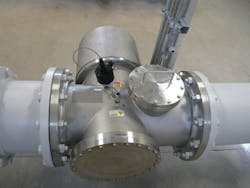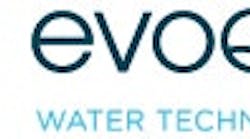The City of Scottsburg, Ind., is located between Louisville, Cincinnati and Indianapolis. It maintains a healthy balance between commercial, industrial and residential community with a celebrated history and bright future. Scottsburg has put a large emphasis on quality of life, and it shows in its scenic parks and lively downtown square.
Challenge
The Scottsburg wastewater treatment plant had been using a chlorine feed system. It is common to upgrade to ultraviolet (UV) disinfection by retrofitting chlorine contact basins with open-channel disinfection. This configuration of placing UV lamps in an open channel has historically been the industry standard. Even today, when new plants are constructed, it is normal to install open-channel UV systems because they are familiar to engineers, consultants and operators. These open, gravity-flow channels are not ideal: They offer poor hydraulic mixing, require a very large footprint, are expensive to build, are difficult to maintain and are vulnerable to fluctuation in flow rate.
Discharged wastewater from communities often becomes drinking and recreational water for downstream communities. Chlorine can react with naturally occurring compounds in the water to produce disinfection byproducts (DBPs), which evidence suggests may be human carcinogens. With UV disinfection, there is no transportation, storage or the risk of handling of toxic or corrosive materials, unlike with chlorine. In addition, microorganisms such as Cryptosporidium and Giardia are exhibiting a growing tolerance to chlorine. Removing these dangers supports public health, nature and aquatic species.
Solution
The city selected a more efficient approach by containing the waste stream in a pipe to disinfect the water within a closed vessel. Closed-vessel ETS-UV disinfection systems are easy to install within existing pipe work, and new construction does not require the large footprint of concrete channels. Disinfection into a closed pipe will ensure optimized hydraulics and prevent the operator from being exposed to the wastewater and UV light.
ETS-UV systems are designed by utilizing computational fluid dynamics (CFD) modeling to design and optimize how the systems will perform; this allows systems to be designed to deliver the highest performance for the least power and head loss.
Two ETS-UV SW-835-14 systems were chosen. The UV chamber is fabricated from 316L stainless steel and contains an automatic wiper to keep the quartz free from fouling. The chamber also features an access hatch that makes routine maintenance easier and more convenient for operators. Each chamber contains medium pressure lamps, which can be removed with effluent in the chamber. The lamps use a Twist-Lok lamp connector for a safe and easy connection. Municipal plants like Scottsburg that only disinfect seasonally can often achieve a two-year lamp life.
“We have been impressed with the ease of use of the closed vessel UV system,” said Jason Combs, facility manager at the plant. “The automatic wipers keep the quartz sleeves clean without constant manual cleaning, and overall, the installation is cleaner and much more compact. The units are installed in a building with climate control making it easy to service the unit or change lamps in a matter of minutes, keeping our employees safe and out of the weather. Water level control issues have been designed out, and we appreciated the improved safety that these modern systems provide to the plant staff.”



